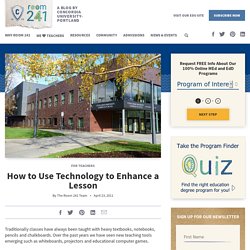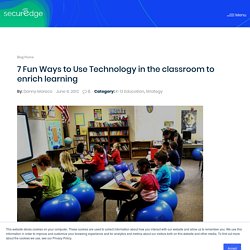

How Technology in Classroom Can Enhance Student Learning. When it comes to the mind, there is so much the average individual doesn’t know. Take the idea of a growth mindset, for example. Many believe that our own abilities and our intelligence remained fixed after some point in time. Some think this happens at birth, while others may think it’s after college or university. The reality, however, is that our minds are constantly growing and adapting. How much depends entirely on our view of intelligence and learning.
These ideas came surfaced when Stanford University’s Carol Dweck researched the subject. That solution is the growth mindset. I’ve shared information about this before, but for this post, I want to explain some dos and don’ts of nurturing a growth mindset. After all, one does not simply follow one trail and begin to grow. What Is the False Growth Mindset? At the start of her research, there were two mindsets that Carol Dweck stumbled upon. All of these ideas are explored by Dweck through her book, Mindset: The New Psychology of Success. How to Use Technology to Enhance Your Classroom : Concordia Masters of Education. Traditionally classes have always been taught with heavy textbooks, notebooks, pencils and chalkboards.

Over the past years we have seen new teaching tools emerging such as whiteboards, projectors and educational computer games. We know change is difficult to accept, especially in the classroom because the old methods are tried and true. They have produced test results and educated individuals for years, but it is time to move forward. New technological advances can not only help your students learn better, but will also allow them to adapt to the fast paced technological environment they are growing up in. Computers Computers can be used for Internet, word processing, presentations, music development, educational games and more. In a setting where every student has their own computer or they are sharing between 2 or 3 students, more students are actively engaged and thinking than in a lecture setting where they may be tuning the teacher out.
Computer Games Word Processing Teacher Websites. 7 Fun Ways to Use Technology in the classroom to enrich learning. Technology in the classroomisthe best learning tool.

The Use of Technology - In Education and Teaching Process - Use of Technology. The effective Use of Technology in Education has changed the face of education and it has created more educational opportunities.

Using Technology to Enhance Teaching & Learning - SMU. Five Ways Teachers Can Use Technology to Help Students. Thomas Edison once said, “Books will soon be obsolete in the public schools…our school system will be completely changed inside of ten years.” Amazingly enough, however, one of our nation’s most important inventors was proven quite wrong.
The American education system has a remarkable resistance to innovation and the classroom experience has changed very little in the 100 years since Edison’s prediction. 8 Strategies for Using Technology in the 21st Century Classroom. We’ve all seen the black and white images of the one-room schoolhouse. Students sit in perfect rows that face a teacher who’s writing on a chalkboard. Up until the last decade, our classrooms haven’t drastically differed from those 100-year-old images. We are so fortunate to be living and teaching in a time of rapid educational change. Instead of personal student chalkboards, a number of students now have access to electronic tablets. Many teachers can now use Smartboards instead of dry-erase boards. Education Technology Tools for Teachers. Massive Open Online Courses make it possible for students of all ages to access high-quality coursework at no cost.
Colleges and universities across the country publish video lectures, podcasts, reading lists, practice exams and more for anyone who wants to learn about a particular subject and/or experience what it’s like to take a college class. Over the last decade, organizations such as Coursera and Khan Academy have taken MOOCs one step further by creating or aggregating thousands of free courses in areas ranging from early American history and civics to trigonometry and multivariable calculus. Khan Academy is a non-profit educational website created by educator Salman Khan in 2006. Khan, a graduate of MIT and Harvard Business School wanted to provide a free world-class education for anyone anywhere. 25 Easy Ways to Use Technology in the Classroom. Although many technology-based teaching methods and resources effectively engage students and build their skills, many educators encounter difficulties when using technology in the classroom.
Maybe a specific platform is too hard to introduce. Or maybe it won’t run on your devices. Despite the challenges, you likely want to enjoy the benefits that education technology can deliver. Using the ones that best apply to you and your students, and keeping the condensed list on your desk for quick reference, consider these 25 easy ways to use technology in the classroom: Offering a Unique Learning Experience.
10 More Educational Technology Concepts Every Teacher Should Know About. In a previous article, I showcased seven must-see educational technology concepts that teachers must stay abreast of to become more effective educators in the digital age. Those are important, but they are certainly not the only ones that are emerging in recent years. Here are some more exciting technologies to keep track of: Alternative input devices. These tools are designed to allow students with disabilities to use computers and related technology easily.
Some alternative input devices include touch screens, modified keyboards, and joysticks that direct a cursor through use of body parts like chins, hands, or feet. Research has also found that teaching outside, even for short stints, improves student attitudes, attendance, and overall health.